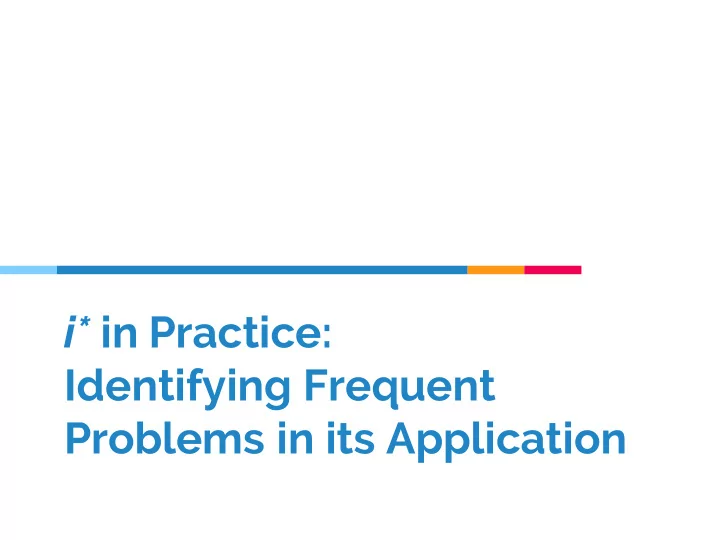

i* in Practice: Identifying Frequent Problems in its Application
The Authors Karina Abad Wilson Pérez Juan Pablo Carvallo Xavier Franch
Agenda Background • Research questions • The Study • The analysis • Results • Guidelines to facilitate the i* language adoption • Threats to validity • Conclusions and Future Work •
The i* Framework Technology, products or services acquired D Technology, products D or services D D D Timely payment Customer D D Invoice purchased D D Organization Quality of products or D D services A S I D Invoice D D Credit Deferred payment D customer D Credit flexibility
The DHARMA Method
Research Questions Is the concept of i* actor, its types and the is-a (sub-typing) relation understood by the junior consultants who participated in the CM construction? Is the concept of dependency, as well as the four types of dependency proposed in the i* language, understood by the junior consultants who participated in the CM construction?
The Study 36 CM constructed by university students (junior consultants), applying DHARMA Infraestructura de la empresa Administracion.de Recursos Humanos Desarrollo Tecnológico Adquisiciones Logística Logístic Operacio- Logística Mercadeo Servicio Interna a de nes de Salida y Ventas Entrada Infraestructura de la empresa Administracion.de Recursos Humanos Desarrollo Tecnológico Adquisiciones Logístic Logística Operacio- Logística Mercadeo Servicio Interna a de nes de Salida y Ventas Entrada Infraestructura de la empresa Administracion.de Recursos Humanos Desarrollo Tecnológico Adquisiciones Logístic Logística Operacio- Logística Mercadeo Servicio Interna a de nes de Salida y Ventas Entrada
RESULTS
1,111 Actors 204 204 Errors 18,36% With errors between 10.87 and 32.00%
Errors concerning actors Type pe Name (58,82%) (41,18%) Type: Public Supplier identified as Person instead of Organization . Name: Sales in Pharmacies -> Pharmacies
839 839 is-a Relations 217 217 Errors 25,86%
2,095 Dependencies 318 318 Errors 15,18%
Errors concerning dependencies Type pe Name Direc rectio tion (26,73%) (32,08%) (41,19%) Type: Large purchase order as Goal instead of softgoal . Name: Teachers acquired -> Theaching services acquired Direction: Supplier -> Commercial contract made -> Sales Supplier <- Commercial contract made <- Sales
Guidelines to facilitate the i* language adoption
1. Identify actors from generic catalogues
1. Identify actors from generic catalogues 2.Specialize actors based on categorization labels ISA
1. Identify actors from generic catalogues 2.Specialize actors based on categorization labels 3.Complete actor’s identification with proper instances ISA
1. Identify actors from generic catalogues 2.Specialize actors based on categorization labels 3.Complete actor’s identification with proper instances 4.Populate the CM with generic dependencies
1. Identify actors from generic catalogues 2.Specialize actors based on categorization labels 3.Complete actor’s identification with proper instances 4.Populate the CM with generic dependencies 5.Refine dependencies in a pairwise way Products acquired Medicine acquired
Threats to validity
Construct validity Internal validity External validity
Conclusions and Future Work
To determine the level of understanding of i* constructs and ▷ identify common errors when using the notation. RQ1 and RQ2: Concepts of actor and dependency are ▷ understood, but a deeper explanation is needed. We believe that our results show that i* can be successfully ▷ adopted by practitioners in the modeling activities. We aim at linking the dependencies with the areas in the value ▷ chain to better distribute the responsibilities of the system. To complete the ongoing study regarding to the guidelines ▷ provided in this work. To conduct a similar study focused on i* SR models, analyzing ▷ goal decomposition, means-end links, etc. Tool support for building i* models applying the guidelines ▷ presented
Th Thanks!
Recommend
More recommend